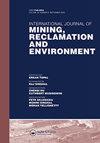考虑颗粒形状和大小分布的分段崩落重力流离散元模型
IF 2.6
3区 工程技术
Q3 ENVIRONMENTAL SCIENCES
International Journal of Mining Reclamation and Environment
Pub Date : 2023-01-23
DOI:10.1080/17480930.2023.2168870
引用次数: 1
摘要
溶洞采矿方法面临的最大挑战之一是贫化,这一过程通常由溶洞材料的重力流控制。采用离散元法(DEM)研究了改变爆破环体材料和崩落废石孔隙度以及改变环体倾角对分段溶洞矿山物质流动的影响。采用Yade软件,在考虑流动岩石颗粒的形状和尺寸分布的情况下,模拟亚水平段纵断面的二维重力流。在不同孔隙度条件下进行了四种模拟,并对模型中的物质流动进行了比较。结果表明:随着环孔隙度的增大,稀释度减小,萃取区高度纵向增大;此外,较低的孔隙率爆破的矿石材料在环可以导致早期稀释进入和扩大的提取区向陷落的废物。最后,研究了环倾角对物料流动和稀释的影响。这些模拟结果表明,随着环倾角的增加和萃取区形状的变化,稀释度增加。本文章由计算机程序翻译,如有差异,请以英文原文为准。
A discrete element modelling of gravity flow in sublevel caving considering the shape and size distribution of particles
ABSTRACT One of the most significant challenges for cave mining methods is dilution, a process which is generally controlled by the gravity flow of caved materials. In this study, the discrete element method (DEM) was used to investigate the effects of changing the porosity of blasted ring material and caved waste rocks and of changing the ring inclination on material flow in a sublevel cave (SLC) mine. Yade software was used to simulate two-dimensional gravity flow in a longitudinal section of the sublevel while taking into consideration the shape and size distribution of the flowing rock particles. Four simulations were generated with different porosities, and the material flow in the models was compared to each other. The results demonstrate that when ring porosity is increased, dilution decreases, and the height of the extraction zone grows longitudinally. Also, a lower porosity of the blasted ore material in the ring can cause early dilution entry and expansion of the extraction zone towards the caved waste.. Finally, the effect of ring inclination on the material flow and dilution was investigated. The results of these simulations show an increased dilution as the ring inclination increases and a change in the shape of the extraction zone.
求助全文
通过发布文献求助,成功后即可免费获取论文全文。
去求助
来源期刊

International Journal of Mining Reclamation and Environment
ENVIRONMENTAL SCIENCES-MINING & MINERAL PROCESSING
CiteScore
5.70
自引率
8.30%
发文量
30
审稿时长
>12 weeks
期刊介绍:
The International Journal of Mining, Reclamation and Environment published research on mining and environmental technology engineering relating to metalliferous deposits, coal, oil sands, and industrial minerals.
We welcome environmental mining research papers that explore:
-Mining environmental impact assessment and permitting-
Mining and processing technologies-
Mining waste management and waste minimization practices in mining-
Mine site closure-
Mining decommissioning and reclamation-
Acid mine drainage.
The International Journal of Mining, Reclamation and Environment welcomes mining research papers that explore:
-Design of surface and underground mines (economics, geotechnical, production scheduling, ventilation)-
Mine planning and optimization-
Mining geostatics-
Mine drilling and blasting technologies-
Mining material handling systems-
Mine equipment
 求助内容:
求助内容: 应助结果提醒方式:
应助结果提醒方式:


